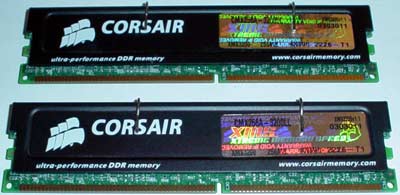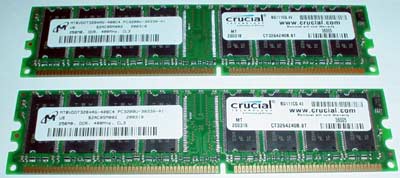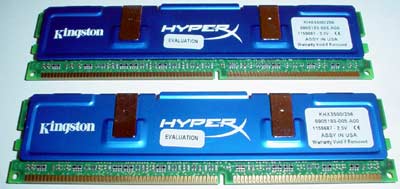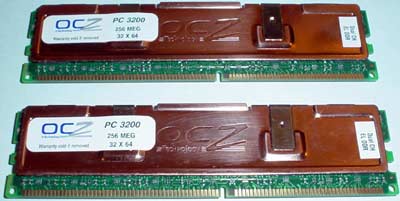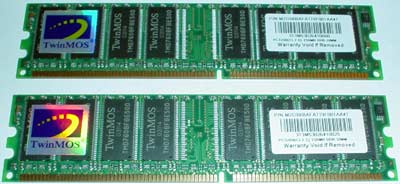
Original Link: https://www.anandtech.com/show/1111
It's not often that we cover seventeen motherboards for just one memory article, but ever since motherboards based on Intel's 800MHz FSB series of chipsets were released at the end of April/beginning of May we felt the need to educate our readers on the severe memory-related issues that have plagued these motherboards.
You'll remember from our 865 Chipset article we encountered a number of compatibility issues with DDR400 SDRAM and the 865PE chipset. It turns out that we weren't the only ones; users all over the web were reporting problems. As a result we felt it was necessary to get to the bottom of these issues, and so took it upon ourselves to test five of the most popular DDR400 memory modules and nearly all the 865PE/875P motherboards we had access to.
The Candidates
For this review we compared five pairs of modules: Corsair LL (Low Latency) TwinX DDR400, Crucial DDR400, OCZ EL DDR400, TwinMOS DDR400, and Kingston HyperX DDR433 (running at 400MHz DDR).
We requested a pair of 256MB modules be sent from every manufacturer to be used in this review. You'll find pictures of the modules we tested below:
UPDATE All graphs on the following pages represent performance numbers from Quake 3 Arena. The "/timedemo 1" benchmark was used.
The Test
|
Performance Test Configuration |
||
| Processor(s): |
Intel
Pentium 4 3.00GHz (800MHz FSB) - HT enabled
|
|
| RAM: |
2 x 256MB
Corsair PC3200 LL Modules (TwinX series)
2 x 256MB Kingston PC3500 HyperX Modules 2 x 256MB OCZ PC3200 EL Modules 2 x 256MB TwinMOS PC3200 Modules 2 x 256MB Crucial PC3200 Modules |
|
| Hard Drive(s): |
Western
Digital 120GB 7200 RPM Special Edition (8MB Buffer)
|
|
| Bus Master Drivers: |
875P: Intel INF Update v5.00.1012, no 875P IAA available at time of publishing
|
|
| Video Card(s): |
ASUS
V8460 Ultra NVIDIA GeForce4 Ti 4600
|
|
| Video Drivers: |
NVIDIA
Detonator 44.03
|
|
| Operation System(s): |
Windows
XP Professional SP1
|
|
| Motherboards: |
ABIT
IC7 (875P) – BIOS 13
ABIT IC7-G (875P) BIOS 13 ABIT IS7 (865PE) BIOS 13 beta 3 ABIT IS7-G (865PE) BIOS 13 beta 3 Albatron PX865PE Pro (865PE) – BIOS 4/17/03 (first release) Albatron PX865PE Pro II (865PE) – BIOS 4/17/03 (first release) AOpen AX4C Max (875P) – BIOS 1.04a ASUS P4C800 Deluxe (875P) - BIOS 1006 ASUS P4P800 Deluxe (865PE) - BIOS 1007 DFI PRO875 LAN Party (875P) – BIOS 5/16/03 Epox 4PCA3+ (875P) – BIOS 06/06/2003 Epox 4PDA2+ (865PE) – BIOS 05/09/03 Gigabyte 8KNXP (875P) – BIOS M4 Gigabyte 8KNXP Ultra (875P) – BIOS F2c Gigabyte 8PENXP (865PE) - BIOS M2 MSI 875P Neo-FIS2R (875P) BIOS 1.4 MSI 865PE Neo2-FIS2R (865PE) – BIOS 1.2 |
|
Testing Methodology
We tested five different memory modules in seventeen different Pentium 4 motherboards, eight of which are based on the 865PE chipset and nine of which are based on the 875P chipset. Each pair of modules was tested at their default SPD timings as well as at the lowest possible programmable timings we were able to reliably achieve. We made sure SPD and manually programmed timings were stable by running SPECviewperf and Prime95.
The majority of motherboards out there accurately display the memory timings you input into its BIOS, but occasionally you will find a motherboard that will display one set of timings in the BIOS that operates at a completely different set of timings once in Windows. For example, the first BIOS revision that shipped with ABIT's 875P series of motherboards did not run the same memory timings inputed into the BIOS as in Windows.
To check to see if the memory timings you input in your BIOS are actually running at those settings, simply download a utility called CPU-Z (version 1.18) here. We used this utility to verify memory timings with all five memory modules on all seventeen motherboards. On a side note, rebooting multiple times did not alter the memory timings initially saved to the CMOS of any of the seventeen motherboards. In other words, once you save your memory timings to CMOS they are there to stay.
In case you're curious, when we refer to memory timings of 2-2-2-5 we are referring to the CAS Latency, RAS to CAS Delay, RAS Precharge, and Precharge Delay (in that order). These terms essentially indicate how many steps it takes for your RAM to complete a certain task. The fewer amount of steps the better, which is why you see users striving for memory timings such as CAS 2-2-2-5 rather than something considerably worse like CAS 3-4-4-8.
ABIT IC7 (875P)
Note: N/B Strap set to PSB533 at 1:1 (DDR400) unless otherwise specified
| Memory @ 400MHz DDR (Default CAS Latency) |
SPD
|
Fastest
Timings
|
| Corsair LL TwinX (CAS 2) |
Pass
|
2-2-2-5
|
| Crucial (CAS 3) |
Pass
|
2.5-3-2-5
|
| Kingston HyperX (CAS 2) |
Pass
|
2-3-2-5
|
| OCZ EL (CAS 2) |
Pass
|
2-3-2-5
|
| TwinMOS (CAS 2.5) |
Pass
|
2.5-3-2-5
|
Comments:
Corsair LL (TwinX): Everything ran smoothly.
Crucial: We were forced to set the N/B Strap option to PSB800 instead of PSB533 to get the memory to work in SPD mode. This lowered performance a little bit, but the memory was stable at these settings regardless.
Kingston HyperX: We were forced to set the N/B Strap option to PSB800 instead of PSB533 to get the memory to work in SPD mode. This lowered performance a little bit, but the memory was stable at these settings regardless.
OCZ EL: We were forced to set the N/B Strap option to PSB800 instead of PSB533 to get this memory to work at all (in SPD mode or manually programmed). This lowered performance a little bit, but the memory was stable at these settings regardless.
TwinMOS: We were forced to set the N/B Strap option to PSB800 instead of PSB533 to get this memory to work at all (in SPD mode or manually programmed). This lowered performance a little bit, but the memory was stable at these settings regardless.
ABIT IC7-G (875P)
Note: N/B Strap set to PSB533 at 1:1 (DDR400) unless otherwise specified
| Memory @ 400MHz DDR (Default CAS Latency) |
SPD
|
Fastest
Timings
|
| Corsair LL TwinX (CAS 2) |
Pass
|
2-2-2-5
|
| Crucial (CAS 3) |
Pass
|
2.5-3-2-5
|
| Kingston HyperX (CAS 2) |
Pass
|
2-3-2-5
|
| OCZ EL (CAS 2) |
Pass
|
2-3-2-5
|
| TwinMOS (CAS 2.5) |
Pass
|
2.5-3-2-5
|
Comments:
Corsair LL (TwinX): Everything ran smoothly.
Crucial: We were forced to set the N/B Strap option to PSB800 instead of PSB533 to get the memory to work in SPD mode. This lowered performance a little bit, but the memory was stable at these settings regardless.
Kingston HyperX: We were forced to set the N/B Strap option to PSB800 instead of PSB533 to get the memory to work in SPD mode. This lowered performance a little bit, but the memory was stable at these settings regardless.
OCZ EL: We were forced to set the N/B Strap option to PSB800 instead of PSB533 to get this memory to work at all (in SPD mode or manually programmed). This lowered performance a little bit, but the memory was stable at these settings regardless.
TwinMOS: We were forced to set the N/B Strap option to PSB800 instead of PSB533 to get this memory to work at all (in SPD mode or manually programmed). This lowered performance a little bit, but the memory was stable at these settings regardless.
ABIT IS7 (865PE)
Note: N/B Strap set to PSB533 at 1:1 (DDR400) unless otherwise specified
| Memory @ 400MHz DDR (Default CAS Latency) |
SPD
|
Fastest
Timings
|
| Corsair LL TwinX (CAS 2) |
Pass
|
2-2-2-5
|
| Crucial (CAS 3) |
Pass
|
2.5-3-2-5
|
| Kingston HyperX (CAS 2) |
Pass
|
2-2-2-5
|
| OCZ EL (CAS 2) |
Pass
|
2-3-2-5
|
| TwinMOS (CAS 2.5) |
Pass
|
2-3-2-5
|
Comments:
Corsair LL (TwinX): Everything ran smoothly.
Crucial: We were forced to set the N/B Strap option to PSB800 instead of PSB533 to get the memory to work in SPD mode. This lowered performance a little bit, but the memory was stable at these settings regardless.
Kingston HyperX: Everything ran smoothly.
OCZ EL: Everything ran smoothly.
TwinMOS: We were forced to set the N/B Strap option to PSB800 instead of PSB533 to get this memory to work at all (in SPD mode or manually programmed). This lowered performance a little bit, but the memory was stable at these settings regardless.
ABIT IS7-G (865PE)
Note: N/B Strap set to PSB533 at 1:1 (DDR400) unless otherwise specified
| Memory @ 400MHz DDR (Default CAS Latency) |
SPD
|
Fastest
Timings
|
| Corsair LL TwinX (CAS 2) |
Pass
|
2-2-2-5
|
| Crucial (CAS 3) |
Pass
|
2.5-3-2-5
|
| Kingston HyperX (CAS 2) |
Pass
|
2-2-2-5
|
| OCZ EL (CAS 2) |
Pass
|
2-3-2-5
|
| TwinMOS (CAS 2.5) |
Pass
|
2-3-2-5
|
Comments:
Corsair LL (TwinX): Everything ran smoothly.
Crucial: We were forced to set the N/B Strap option to PSB800 instead of PSB533 to get the memory to work in SPD mode. This lowered performance a little bit, but the memory was stable at these settings regardless.
Kingston HyperX: Everything ran smoothly.
OCZ EL: Everything ran smoothly.
TwinMOS: We were forced to set the N/B Strap option to PSB800 instead of PSB533 to get this memory to work at all (in SPD mode or manually programmed). This lowered performance a little bit, but the memory was stable at these settings regardless.
Albatron PX865PE Pro (865PE)
| Memory @ 400MHz DDR (Default CAS Latency) |
SPD
|
Fastest
Timings
|
| Corsair LL TwinX (CAS 2) |
Pass
|
2-2-2-5
|
| Crucial (CAS 3) |
Pass
|
2.5-3-2-5
|
| Kingston HyperX (CAS 2) |
Pass
|
2-2-2-5
|
| OCZ EL (CAS 2) |
Pass
|
2-3-2-5
|
| TwinMOS (CAS 2.5) |
Pass
|
2-3-2-5
|
Comments:
Corsair LL (TwinX): During a warm reboot at CAS 2-2-2-5 timings we very occasionally experienced no-POST issues. Turning off and then turning on the system again was the most effective way of recovering. We are still uncertain if this was a memory timing issue however.
Crucial: Everything ran smoothly.
Kingston HyperX: Everything ran smoothly.
OCZ EL: Everything ran smoothly.
TwinMOS: Everything ran smoothly.
Albatron PX865PE Pro II (865PE)
| Memory @ 400MHz DDR (Default CAS Latency) |
SPD
|
Fastest
Timings
|
| Corsair LL TwinX (CAS 2) |
Pass
|
2-2-2-5
|
| Crucial (CAS 3) |
Pass
|
2.5-3-2-5
|
| Kingston HyperX (CAS 2) |
Pass
|
2-2-2-5
|
| OCZ EL (CAS 2) |
Pass
|
2-3-2-5
|
| TwinMOS (CAS 2.5) |
Pass
|
2-3-2-5
|
Comments:
Corsair LL (TwinX): Everything ran smoothly, expect for during warm reboots at CAS 2-2-2-5 timings where we very occasionally experienced no-POST issues. Turning off and then turning on the system again was the most effective way of recovering. We are still uncertain if this was a memory timing issue however.
Crucial: Everything ran smoothly.
Kingston HyperX: Everything ran smoothly.
OCZ EL: Everything ran smoothly.
TwinMOS: Everything ran smoothly.
AOpen AX4C Max (875P)
| Memory @ 400MHz DDR (Default CAS Latency) |
SPD
|
Fastest
Timings
|
| Corsair LL TwinX (CAS 2) |
Pass
|
2-2-2-5
|
| Crucial (CAS 3) |
Pass
|
2.5-3-2-5
|
| Kingston HyperX (CAS 2) |
Pass
|
2-3-2-5
|
| OCZ EL (CAS 2) |
Pass
|
2-3-2-5
|
| TwinMOS (CAS 2.5) |
Pass
|
2-3-2-5
|
Comments:
Corsair LL (TwinX): Everything ran smoothly.
Crucial: Everything ran smoothly.
Kingston HyperX: Everything ran smoothly.
OCZ EL: Everything ran smoothly.
TwinMOS: Everything ran smoothly.
ASUS P4C800 Deluxe (875P)
| Memory @ 400MHz DDR (Default CAS Latency) |
SPD
|
Fastest
Timings
|
| Corsair LL TwinX (CAS 2) |
Pass
|
2-2-2-5
|
| Crucial (CAS 3) |
Pass
|
2.5-3-2-5
|
| Kingston HyperX (CAS 2) |
Pass
|
2-3-2-5
|
| OCZ EL (CAS 2) |
Pass
|
2-3-2-5
|
| TwinMOS (CAS 2.5) |
Pass
|
2.5-3-2-5
|
Comments:
Corsair LL (TwinX): Everything ran smoothly.
Crucial: Everything ran smoothly.
Kingston HyperX: Everything ran smoothly.
OCZ EL: Everything ran smoothly.
TwinMOS: Everything ran smoothly.
ASUS P4P800 Deluxe (865PE)
Note: MAM (Memory Acceleration Mode) was enabled and Performance Mode set to Turbo unless otherwise specified.
| Memory @ 400MHz DDR (Default CAS Latency) |
SPD
|
Fastest
Timings
|
| Corsair LL TwinX (CAS 2) |
Pass
|
2-2-2-5
|
| Crucial (CAS 3) |
Pass
|
2.5-3-2-5
|
| Kingston HyperX (CAS 2) |
Pass
|
2-2-2-5
|
| OCZ EL (CAS 2) |
Pass
|
2-3-2-5
|
| TwinMOS (CAS 2.5) |
Pass
|
2.5-3-2-5
|
Comments:
Corsair LL (TwinX): Everything ran smoothly.
Crucial: Everything ran smoothly.
Kingston HyperX: Everything ran smoothly.
OCZ EL: Everything ran smoothly.
TwinMOS: Everything ran smoothly.
DFI PRO875 LAN Party (875P)
| Memory @ 400MHz DDR (Default CAS Latency) |
SPD
|
Fastest
Timings
|
| Corsair LL TwinX (CAS 2) |
Pass
|
2-2-2-5
|
| Crucial (CAS 3) |
Pass
|
2.5-3-2-5
|
| Kingston HyperX (CAS 2) |
Pass
|
2-3-2-5
|
| OCZ EL (CAS 2) |
Pass
|
2-3-2-5
|
| TwinMOS (CAS 2.5) |
Pass
|
2-3-2-5
|
Comments:
Corsair LL (TwinX): Everything ran smoothly except for during warm rebooting at CAS 2-2-2-5 where we very occasionally experienced no-POST issues. Turning off and then turning on the system again was the most effective way of recovering.
Crucial: Everything ran smoothly.
Kingston HyperX: Everything ran smoothly.
OCZ EL: Everything ran smoothly.
TwinMOS: Everything ran smoothly.
Epox 4PCA3+ (875P)
| Memory @ 400MHz DDR (Default CAS Latency) |
SPD
|
Fastest
Timings
|
| Corsair LL TwinX (CAS 2) |
Pass
|
2-2-2-5
|
| Crucial (CAS 3) |
Pass
|
2.5-3-2-5
|
| Kingston HyperX (CAS 2) |
Pass
|
2-3-2-5
|
| OCZ EL (CAS 2) |
Pass
|
2-3-2-5
|
| TwinMOS (CAS 2.5) |
Pass
|
2.5-2-2-5
|
Comments:
Corsair LL (TwinX): Everything ran smoothly.
Crucial: Everything ran smoothly.
Kingston HyperX: Everything ran smoothly.
OCZ EL: Everything ran smoothly.
TwinMOS: Everything ran smoothly for the most part. However, we encountered an issue where SPD timings would simply not load correctly unless you cleared CMOS. Even then, we were unable to do warm reboots with SPD timings loaded.
Epox 4PDA2+ (865PE)
| Memory @ 400MHz DDR (Default CAS Latency) |
SPD
|
Fastest
Timings
|
| Corsair LL TwinX (CAS 2) |
Pass
|
2-2-2-5
|
| Crucial (CAS 3) |
Pass
|
2.5-3-2-5
|
| Kingston HyperX (CAS 2) |
Pass
|
2-3-2-5
|
| OCZ EL (CAS 2) |
Pass
|
2-3-2-5
|
| TwinMOS (CAS 2.5) |
Pass
|
2.5-3-2-5
|
Comments:
Corsair LL (TwinX): Everything ran smoothly.
Crucial: Everything ran smoothly.
Kingston HyperX: Everything ran smoothly.
OCZ EL: Everything ran smoothly.
TwinMOS: Everything ran smoothly.
Gigabyte 8KNXP (875P)
| Memory @ 400MHz DDR (Default CAS Latency) |
SPD
|
Fastest
Timings
|
| Corsair LL TwinX (CAS 2) |
Pass
|
2-2-2-5
|
| Crucial (CAS 3) |
Pass
|
2.5-3-2-5
|
| Kingston HyperX (CAS 2) |
Pass
|
2-3-2-5
|
| OCZ EL (CAS 2) |
Pass
|
2-3-2-5
|
| TwinMOS (CAS 2.5) |
Pass
|
2.5-3-2-5
|
Comments:
Corsair LL (TwinX): Everything ran smoothly.
Crucial: Everything ran smoothly.
Kingston HyperX: Everything ran smoothly.
OCZ EL: Everything ran smoothly.
TwinMOS: Everything ran smoothly. We should note that the 8KNXP BIOS did not allow lower than a CL (CAS Latency) of 2.5, so we were unable to see if this TwinMOS memory was capable of CL 2.0.
Gigabyte 8KNXP Ultra (875P)
| Memory @ 400MHz DDR (Default CAS Latency) |
SPD
|
Fastest
Timings
|
| Corsair LL TwinX (CAS 2) |
Pass
|
2-2-2-5
|
| Crucial (CAS 3) |
Pass
|
2.5-3-2-5
|
| Kingston HyperX (CAS 2) |
Pass
|
2-3-2-5
|
| OCZ EL (CAS 2) |
Pass
|
2-3-2-5
|
| TwinMOS (CAS 2.5) |
Pass
|
2.5-3-2-5
|
Comments:
Corsair LL (TwinX): Everything ran smoothly.
Crucial: Everything ran smoothly.
Kingston HyperX: Everything ran smoothly.
OCZ EL: Everything ran smoothly.
TwinMOS: Everything ran smoothly. We should note that the 8KNXP BIOS did not allow lower than a CL (CAS Latency) of 2.5, so we were unable to see if this TwinMOS memory was capable of CL 2.0.
Gigabyte 8PENXP (865PE)
| Memory @ 400MHz DDR (Default CAS Latency) |
SPD
|
Fastest
Timings
|
| Corsair LL TwinX (CAS 2) |
Pass
|
2-2-2-5
|
| Crucial (CAS 3) |
Pass
|
2.5-3-2-5
|
| Kingston HyperX (CAS 2) |
Pass
|
2-2-2-5
|
| OCZ EL (CAS 2) |
Pass
|
2-3-2-5
|
| TwinMOS (CAS 2.5) |
Pass
|
2.5-3-2-5
|
Comments:
Corsair LL (TwinX): Everything ran smoothly.
Crucial: Everything ran smoothly.
Kingston HyperX: Everything ran smoothly.
OCZ EL: Everything ran smoothly.
TwinMOS: Everything ran smoothly. We should note that the 8PENXP BIOS did not allow lower than a CL (CAS Latency) of 2.5, so we were unable to see if this TwinMOS memory was capable of CL 2.0.
MSI 865PE Neo2-FIS2R (865PE)
Note: Performance Mode set to Ultra-Turbo unless otherwise specified.
| Memory @ 400MHz DDR (Default CAS Latency) |
SPD
|
Fastest
Timings
|
| Corsair LL TwinX (CAS 2) |
Pass
|
2-2-2-5
|
| Crucial (CAS 3) |
Fail
|
Fail
|
| Kingston HyperX (CAS 2) |
Pass
|
2.5-2-2-5
|
| OCZ EL (CAS 2) |
Pass
|
2-3-2-5
|
| TwinMOS (CAS 2.5) |
Pass
|
2-3-2-5
|
Comments:
Corsair LL (TwinX): Everything ran smoothly.
Crucial: Our Crucial modules completely failed to work at all with the MSI 865PE Neo2-FIS2R. We were able to POST but unable to enter the BIOS at any time.
Kingston HyperX: Everything ran smoothly. We were forced to lower the Performance Mode option to Turbo instead of Ultra-Turbo to get SPD and manually programmed memory timings to function. Also, while manually programming these modules timings, we were unable to reach CAS 2.0 without the Neo2-FIS2R dropping the memory frequency to 320MHz DDR. CAS 2.5 was the lowest we were allowed to go to be able to operate at 400MHz DDR.
OCZ EL: Everything ran smoothly. We were forced to lower the Performance Mode option to Turbo instead of Ultra-Turbo to get SPD and manually programmed memory timings to function.
TwinMOS: Everything ran smoothly. We were forced to lower the Performance Mode option to Turbo instead of Ultra-Turbo to get SPD and manually programmed memory timings to function.
MSI 875P Neo-FIS2R (875P)
| Memory @ 400MHz DDR (Default CAS Latency) |
SPD
|
Fastest
Timings
|
| Corsair LL TwinX (CAS 2) |
Pass
|
2-2-2-5
|
| Crucial (CAS 3) |
Pass
|
3-2-2-5
|
| Kingston HyperX (CAS 2) |
Pass
|
2.5-2-2-5
|
| OCZ EL (CAS 2) |
Pass
|
2.5-3-2-5
|
| TwinMOS (CAS 2.5) |
Pass
|
2.5-3-2-5
|
Comments:
Corsair LL (TwinX): Everything ran smoothly.
Crucial: Everything ran smoothly.
Kingston HyperX: Everything ran smoothly.
OCZ EL: Everything ran smoothly.
TwinMOS: Everything ran smoothly.
Final Words
It has been many weeks since 865PE and 875P motherboards were released onto the market, and we can say without a doubt that there have been some growing pains. Luckily though motherboard manufacturers have been diligently working on their BIOSes and it shows; memory compatibility and performance is much better today than it was one to two months ago.
After countless hours of testing there is no doubt that Corsair LL (Low Latency) PC3200 modules are the fastest and most compatible DDR memory modules to pair with your 865PE or 875P motherboard (regular CAS2.0 Corsair modules are just as good as LL/TwinX modules). Initially we had the most problems with Corsair's modules, but thankfully motherboard manufacturers were able to come through with solid BIOS releases that remedied all of these issues.
While Corsair LL modules are certainly the best modules you can pair with an 865PE or 875P motherboard they are significantly more expensive than most other modules. Kingston HyperX or OCZ EL PC3200 modules are other excellent alternatives. However when it comes right down to it you can't beat Crucial in value. Since the difference between all five memory modules was very slim to begin with (the largest variance was 3% in one instance), Crucial's price advantage over Corsair is significant. In fact, buying two PC3200 Crucial modules is about 30% cheaper than buying two PC3200 Corsair LL modules (be it LL/TwinX or vanilla CAS2.0 modules).
Looking at our performance and compatibility test results in combination with Crucial's excellent prices its quite clear that Crucial PC3200 memory modules are the best bang-for-the-buck memory modules available for your 865PE or 875P motherboard.
Stay tuned as we take a more in depth look at the most popular 865PE and 875P
motherboards later this week.

